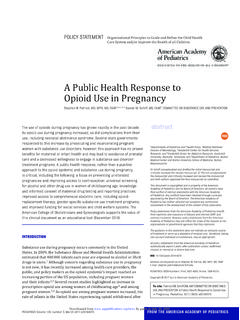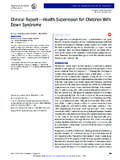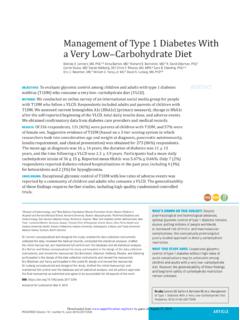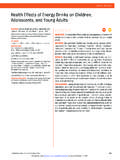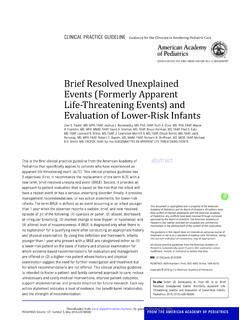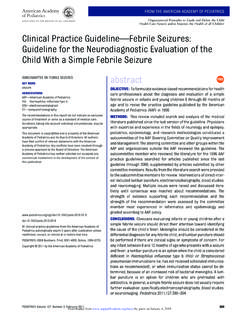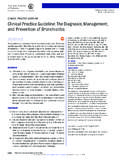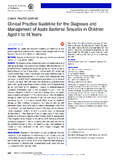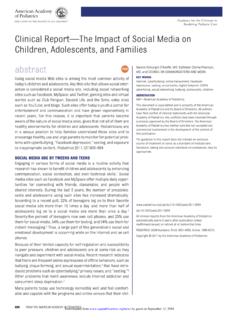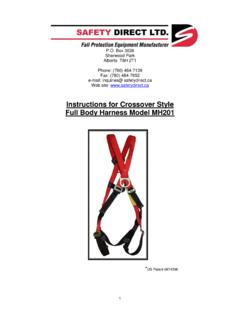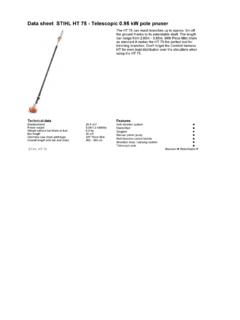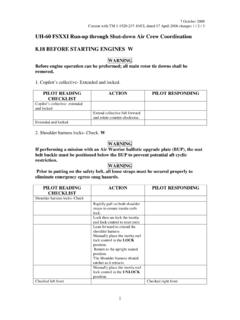Transcription of Health Care System and/or Improve the Health of all ...
1 Policy Statement Child Passenger SafetyabstractChild passenger safety has dramatically evolved over the past de-cade; however, motor vehicle crashes continue to be the leadingcause of death of children 4 years and older. This policy statementprovides 4 evidence-based recommendations for best practices inthe choice of a child restraint System to optimize safety in passen-ger vehicles for children from birth through adolescence: (1) rear-facing car safety seats for most infants up to 2 years of age; (2)forward-facing car safety seats for most children through 4 yearsof age; (3) belt-positioning booster seats for most children through8 years of age; and (4) lap-and-shoulder seat belts for all who haveoutgrown booster seats. In addition, a fifth evidence-based recom-mendation is for all children younger than 13 years to ride in therear seats of vehicles. It is important to note that every transition isassociated with some decrease in protection; therefore, parentsshould be encouraged to delay these transitions for as long aspossible.
2 These recommendations are presented in the form of analgorithm that is intended to facilitate implementation of the rec-ommendations by pediatricians to their patients and families andshould cover most situations that pediatricians will encounter inpractice. The American Academy of Pediatrics urges all pediatri-cians to know and promote these recommendations as part of childpassenger safety anticipatory guidance at every ;127:788 793 Improved vehicle crashworthiness and greater use of child restraintsystems have significantly affected the safety of children in automo-biles. Major shifts in child restraint use, particularly the use of boosterseats among older children, have occurred in response to public edu-cation programs and enhancements to child restraint laws in nearlyevery 3In addition, there has been a substantial increase inscientific evidence on which to base recommendations for best prac-tices in child passenger safety.
3 Current estimates of child restrainteffectiveness indicate that child safety seats reduce the risk of injuryby 71% to 82%4,5and reduce the risk of death by 28% when comparedwith those for children of similar ages in seat seatsreduce the risk of nonfatal injury among 4- to 8-year-olds by 45%compared with seat this progress, approximately1500 children younger than 16 years die in motor vehicle crasheseach year in the United States, nearly half of whom were American Academy of Pediatrics (AAP) strongly supports optimalsafety for children and adolescents of all ages during all forms of ON INJURY, VIOLENCE, AND POISON PREVENTIONKEY WORDS child passenger safety, motor vehicle crash, child restraintsystemABBREVIATIONSAAP American Academy of PediatricsCSS car safety seatThis document is copyrighted and is property of the AmericanAcademy of Pediatrics and its Board of Directors. All authorshave filed conflict of interest statements with the AmericanAcademy of Pediatrics.
4 Any conflicts have been resolved througha process approved by the Board of Directors. The AmericanAcademy of Pediatrics has neither solicited nor accepted anycommercial involvement in the development of the content ofthis policy statements from the American Academy of Pediatricsautomatically expire 5 years after publication unless reaffirmed,revised, or retired at or before that (ISSN Numbers: Print, 0031-4005; Online, 1098-4275).Copyright 2011 by the American Academy of PediatricsOrganizational Principles to Guide and Define the ChildHealth Care System and/or Improve the Health of all Children788 FROM THE AMERICAN ACADEMY OF PEDIATRICS by guest on August 21, from This policy statement provides 5evidence-based recommendations forbest practices to optimize safety in pas-senger vehicles for all children, frombirth through adolescence (a summaryof recommendations is listed in Table 1):1. All infants and toddlers should ridein a rear-facing car safety seat(CSS) until they are 2 years of ageTABLE 1 Summary of Best-Practice RecommendationsBest-Practice RecommendationComplementary InformationAll infants and toddlers should ride in a rear-facing car safety seat(CSS) until they are2yofageoruntil they reach the highestweight or height allowed by the manufacturer of their seats usually have a handle for carrying and can be snappedin and out of a base that is installed in the vehicle.
5 They can only beused rear-facing. Convertible CSSs can be used either forward- orrear-facing and typically have higher rear-facing weight and heightlimits than infant-only children using infant-only seats reach the highest weight for theirseat, they should continue to ride rear-facing in a convertible seat foras long as possible. Most currently available convertible seats can beused rear-facing to at least 35 CSSs are seats that can be used forward-facing with aharness System and then, when the child exceeds the height orweight limit for the harness, as a booster seat with the children2yorolder, or those younger than 2 y who have outgrownthe rear-facing weight or height limit for their CSS, should use aforward-facing CSS with a harness for as long as possible, up to thehighest weight or height allowed by the manufacturer of their models of convertible and combination CSSs can accommodatechildren up to 65 or 80 lb when used forward-facing.
6 The lowestmaximum weight limit for currently available forward-facing CSSs is40 children whose weight or height is above the forward-facing limitfor their CSS should use a belt-positioning booster seat until thevehicle lap-and-shoulder seat belt fits properly, typically when theyhave reached 4 feet 9 inches in height and are between 8 and 12 yof is a safety advantage for young children to remain in CSSs with aharness for as long as possible before transitioning to booster children are old enough and large enough to use the vehicleseat belt alone, they should always use lap-and-shoulder seat beltsfor optimal seats function by positioning the child so that both the lap andshoulder portions of the vehicle seat belt fit properly; the lap portionof the belt should fit low across the hips and pelvis, and the shoulderportion should fit across the middle of the shoulder and chest. Theycome in both high-back (a seat back that extends up beyond thechild s head) and backless lap portion of the belt should fit low across the hips and pelvis, andthe shoulder portion should fit across the middle of the shoulder andchest when the child sits with his or her back against the vehicleseat back.
7 If they do not, then the child is likely too small to use thevehicle seat belt alone and should continue to use a belt-positioningbooster should be installed tightly either with the vehicle seat belt or withthe LATCH System , if available. LATCH is a System of attaching a CSS tothe vehicle that does not use the seat belt. It wasdesigned to easeinstallation of the CSS. Whether parents use LATCH or the seat belt, theyshould always ensure a tight installation of the CSS into the children younger than 13 y should be restrained in the rear seatsof vehicles for optimal indicates lower anchors and tethers for THE AMERICAN ACADEMY OF PEDIATRICSPEDIATRICS Volume 127, Number 4, April 2011789 by guest on August 21, from or until they reach the highestweight or height allowed by themanufacturer of their All children 2 years or older, orthose younger than 2 years whohave outgrown the rear-facingweight or height limit for theirCSS, should use a forward-facingCSS with a harness for as long aspossible, up to the highest weightor height allowed by the manufac-turer of their All children whose weight or height isabove the forward-facing limit fortheir CSS should use a belt-positioning booster seat until the ve-hicle lap-and-shoulder seat belt fitsproperly.
8 Typically when they havereached 4 feet 9 inches in height andare between 8 and 12 years of When children are old enough andlarge enough to use the vehicle seatbelt alone, they should always uselap-and-shoulder seat belts for opti-mal All children younger than 13 yearsshould be restrained in the rearFIGURE 1 Algorithm to guide the implementation of best-practice recommendations for optimal child passenger safety (see Table 1 for a summary of recommenda-tions and Table 2 for definitions and explanations).790 FROM THE AMERICAN ACADEMY OF PEDIATRICS by guest on August 21, from seats of vehicles for should be noted that the recom-mendation that all children youngerthan 2 years be restrained in aninfant-only or convertible CSS usedrear-facing represents a significantchange from previous AAP policy andis based on new data from the UnitedStates9as well as extensive experi-ence in ,11It is important tonote that most currently availableCSSs have weight limits for rear-facing use that can accommodatethe new considerations contained in thispolicy statement are relevant to com-mercial airline travel as well and arenoted in the accompanying technical AAP policy statements pro-vide specific recommendations to opti-mize safety for preterm and low birthweight infants,14children in schoolbuses,15and children using other formsof travel and recreational 18 Inaddition.
9 Complementary AAP policystatements provide recommendationsfor teenaged drivers19and the safetransport of newborn infants20and chil-dren with special Health care ,22 TABLE 2 Explanations of Decision Points and Additional ResourcesChildren with certain temporary or permanent physical and behavioral conditionssuch as altered muscle tone, decreased neurologic control, skeletal abnormalities,or airway compromise may preclude the use of regular CSSs and may require theuse of regular CSSs may require specialized restraint AAP has issued a policy statement that provides specific guidance on best-practicerecommendations for children with special Health care needs ( ). To locate a child passenger safety techni-cian in your area with special training in special Health needs, go younger than 2 y have relatively large heads and several structural features oftheir neck and spine that place them at particularly high risk of head and spineinjuries in motor vehicle crashes.
10 Rear-facing CSSs provide optimal support to thehead and spine in the event of a crash, and evidence indicates that this benefitextends to children up who are2yofageorolder and small for age may need to be evaluated likechildren younger than 2 y. Consult a child passenger safety technician withenhanced training in special needs or other resources for AAP annually updates information on child restraint systems currently available inthe United States ( ). More recent productshave higher weight limits and should be used when possible. In general, childrenshould remain in a child restraint System until they outgrow the weight or heightlimits for its intended children 2 to 8 y of age are not large enough to fit properly in the vehicle seatbelt and will require a CSS or booster seat for optimal restraint. A belt-positioningbooster seat positions a child so that the lap and shoulder portions of the seat beltfit properly: the lap portion low across the hips and pelvis and the shoulder portionacross the middle of the shoulder and children shorter than 4 feet 9 inches in height will not fit properly in vehicle lap-and-shoulder seat 3 questions are an evaluation to determine whether a child is ready to berestrained by the vehicle seat belt without a booster seat.
